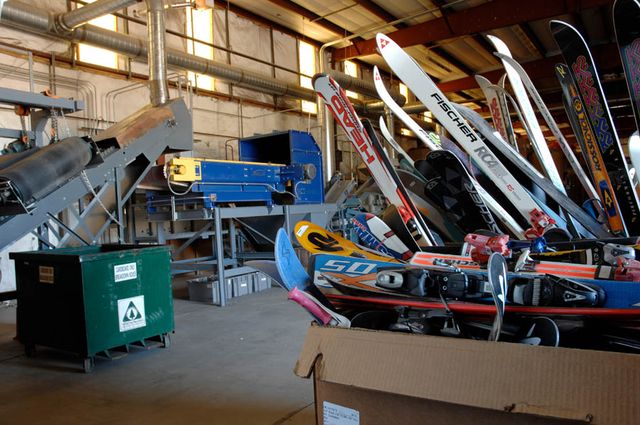
Way back in October of 2009 we wrote a story about a nascent ski and snowboard recycling program that the trade group Snowsports Industries of America (SIA) had launched. Since then, the program has made slow but steady progress and has set up collection sites at more than 65 retail locations in Colorado and Utah and is looking to expand to six other nearby states. So far, 700,000 pounds of used gear have been collectedÔÇödiverting it from landfills and turning it into usable, valuable productsÔÇöbut the program expects it will soon be diverting at least one million pounds of gear from landfills each year.
We spoke with the (SSRP) director Greg Schneider to get a full update on where the program is headed.
A MUCH-NEEDED FINANCIAL BOOST
“Everyone thinks recycling is free,” says Schneider. It is anything butÔÇöespecially in the earliest stages of setting up a recycling infrastructure. But in January of 2011, the SIA, along with a recycling company called Waste-Not Recycling, based in Johnstown, Colorado, received an important economic boost through a $425,000 grant that was used to purchase the type of machines needed to put skis and snowboards through a six-step progression during which the materials (plastics and metals, mostly) are separated and processed.
However, the grant only takes the program so far. Schneider needed to find a way to make it sustainable. This meant setting up a logistical framework that would connect the used gearÔÇöresting in the dusty corners of closets and long-ignored garage raftersÔÇöwith the recycling center. His objectives were not just to find a way to do that cheaply, but also in a manner that would not do more harm than good.
The process “has to be cost-neutral and it has to be carbon neutral,” he says. “Those are the two aspects of it that we have to be conscious of.” Gaining those objectives is an ongoing project, but the SSRP has managed to strike a partnership with the Salvation Army, which sends trucks to a network of retailers that have agreed to become SSRP collection sites. “We're looking at using trucks that are dead-heading, in order to save energy, and we're trying to work with large retailers that might have trucks fleets, as well,” Schneider explains.
While the grant, which was issued by the state of Colorado, helped the program establish itself, it needs support from skiers and snowboarders in order to sustain itself. To provide ongoing funding, participating retailers ask their customers to pay a $1 surcharge on each piece of new ski or snowboard equipment they buy, and they also tack on $1 to each adult ski or snowboard rental. There's also a “service fee opt-in, so anyone who brings [skis or a snowboard] in for tuning” can also contribute to the program.
REINCARNATIONS
The story does not end when the gear goes into the shredders; that's really just the first step in its next stage in life. The component materials are then sold to manufacturers. “The ultimate goal is to turn [the materials] back into skis and snowboards,” says Schneider. But, in the meantime, composite lumber, pavers, and cultured rocks are being produced, in part, with former skis and snowboards.
Inching closer to the end goal, SSRP is working with a skateboard manufacturer (which Schneider declined to name) that is starting to use polymers derived from used skis and snowboards to construct its boards.
SSRP is also testing and designing ways that lumber manufactured from skis and snowboards can be made into things like display cases for retail stores, as a way to make the end product more visible to consumers, which in turn might make them more interested in recycling their old gear.
TURNS AHEAD
Schneider has looked into marketing composite lumber or other products derived directly from the ski and snowboard stock SSRP collects, but he found a disconnect between the idea and the economic realities. The market for materials like these is small, and the costs will only drop as the mountains of materials collected start to grow much larger.
“You have to sell tons of this to make money,” he says. A ski resort is willing to pay a small premium, but there are only so many ski resorts.”You look at existing composite lumber manufacturers and they see this as a very small source [of raw materials].” On the other side of the supply chain, “the average Joe consumer couldnÔÇÖt care less” if the composite lumber they buy for a deck has ground-up ski equip in it, he adds.
That said, there are millions of unused skis and snowboards and thousands of ski shops across the country that could help the SSRP grow. It's hoping to expand by collecting gear in California and then up the West Coast to Oregon and WashingtonÔÇöbut that also entails partnering with recycling facilities in those regions. Longer term, SSRP is looking for a recycling partner that would allow it to expand to the East Coast as well.
Ski stores in the Reno and Tahoe area are coming online now and will be ready to start collecting used gear by the end of the season. If you're in Colorado or near Salt Lake City, map. If not, you might want to hold onto those old boards until SSRP comes to your home town. If nothing else, you can strap them to the wall and call them art.
ÔÇöMary Catherine O'Connor